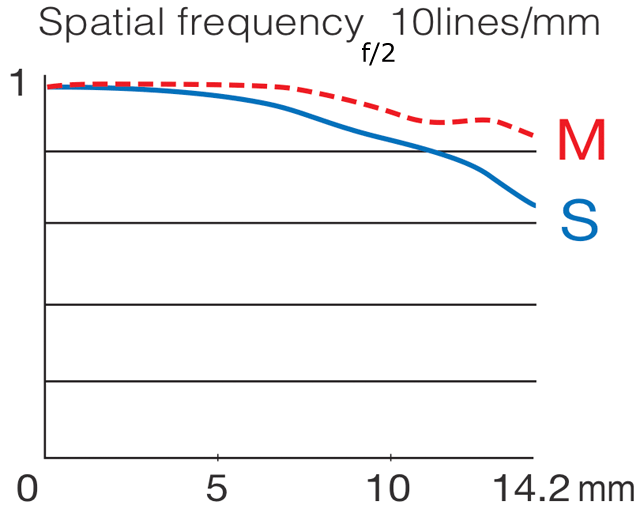EXCERPT page containing first few paragraphs. 2024-04-18 11:19:31
UA_SEARCH_BOT_null @ 3.143.168.172
For full access, subscribe here. Or click title to login. ![]()
MTF Charts for Fujifilm X100
The MTF chart suggests a lens with outstanding performance showing exceptionally high contrast overall, as well as for fine details.
Most likely the lens peaks at f/4, but Fuji does not supply MTF charts for f/2.8 or f/5.6 or f/8.
Stop down to f/5.6 to retain all the goodness of f/4 but with more depth of field. Aperture f/2.8 is likely to yield the lion’s share of the performance to be gained by stopping down from f/2. Aperture f/8 wil show some loss of contrast, both overall and on fine details, but this should not be only a small concern— use f/8 when needed, but don’t use it if not needed, for maximum brilliance by sticking to f/4 - f/5.6.
Mouse-over the graphs to see f/2 change to f/4. S and M are sagittal and meridional (radial) contrast.
Article continues for subscribers...
Diglloyd Guide to Mirrorless is by yearly subscription. Subscribe now for about 25 cents a day ($90/year).
BEST DEAL: get full access to ALL 8 PUBLICATIONS for only about 75 cents a day!
Diglloyd Guide to Mirrorless offers comprehensive integrated coverage of most APS-C and full frame mirrorless cameras and lenses.
Special emphasis is placed on Sony full-frame, including Sony lenses and the high performance Zeiss Batis and Zeiss Loxia lenses plus Rokinon/Samyang and others. Fujifilm X, Olympus and Panasonic M4/3, Sigma dp Merrill and dp/sd Quattro are also covered in depth. Years in the making, it offers a wealth of material for choosing and using a mirrorless camera.
- Make better images by learning how to get the best results right away. For example, the best way to set up your Sony camera.
- Save money by choosing the right lens for your needs the first time, particularly with the numerous lenses available for Sony.
- Make better images, a sort of “cheat sheet” saving yourself months or years of ad-hoc learning—best practices and how-to and processing parameters are discussed and shown.
- Jaw-dropping image quality found nowhere else utilizing Retina-grade images up to full camera resolution, plus large crops.
- Real world examples with insights found nowhere else. Make sharper images just by understanding lens behavior you won’t read about elsewhere.
- Aperture series from wide open through stopped down, showing the full range of lens performance and bokeh.
- Optical quality analysis of field curvature, focus shift, sharpness, flare, distortion, and performance in the field.
Want a preview? Click on any page below to see an excerpt as well as extensive blog coverage, for example on Sony.



